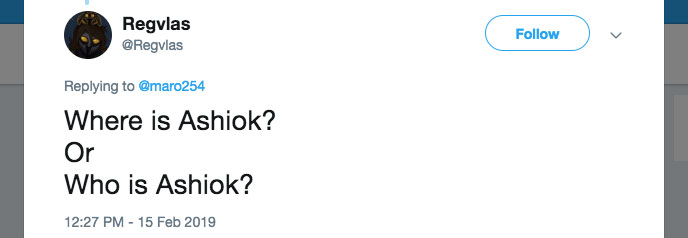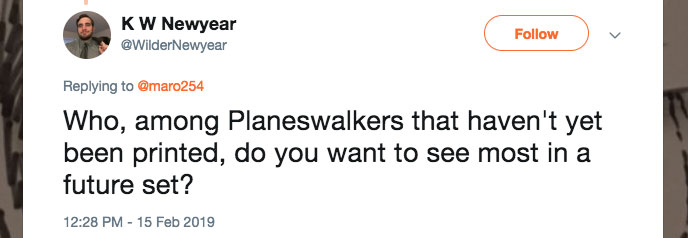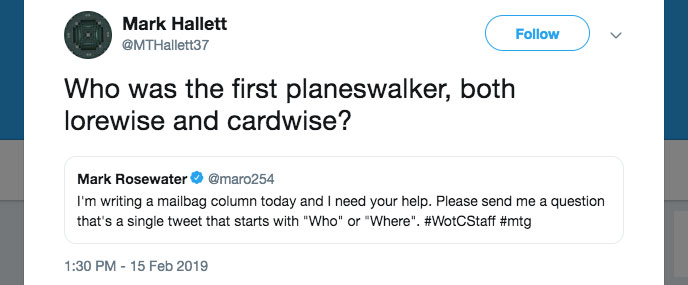You Know Who
Ten years ago, I started a mailbag series where I planned to ask each of the six question words (Who, What, Where, Why, When, and How). Here's what I've written already:
- "Know How" (Parts 1 and 2)
- "Why? Because We Like You"
- "Say When"
- "Know What?"
My plan is for today and next week to finish up this mega-series of mailbag columns. I'll be answering "who" questions today and "where" questions next week. Here's the tweet I put out to gather the questions:
I'm writing a mailbag column today and I need your help. Please send me a question that's a single tweet that starts with "Who" or "Where". #WotCStaff #mtg
— Mark Rosewater (@maro254) February 15, 2019
As always, I'm going to answer as many questions as I can, but there are reasons I might not get to your question:
- I have an allotted word count, as my article has to get translated into many languages, and I've learned it's good to be nice to your editors and translators. With so many questions, I just didn't have room to answer them all.
- Someone else might have asked the same question. I tried as much as possible to answer the first person who asked the question.
- The reason I'm starting each of these mailbags with different words is to try and generate different styles of questions. Some people asked "who" or "where" questions that weren't really "who" or "where" questions, and I skipped them.
- Some questions had answers that either I didn't know or were outside of my expertise, and I didn't feel qualified to properly answer them.
- There are some topics I am not allowed to talk about, and questions around those topics were skipped.
With that out of the way, on with the questions!

Where is Ashiok? That's a question for next week.
Who is Ashiok? I can answer that today.
The short answer is nobody knows. That question has never been answered in any of the stories. The longer answer is the unknown of the character is a defining quality of Ashiok. If we came out tomorrow and just said Ashiok is such and such, I believe it would lessen the character. The mysterious qualities of Ashiok allow individual players to fill in the gaps with what they believe and bond with the character.
Will we ever learn more about Ashiok? I assume so. There are things to learn. Will we ever learn everything about Ashiok? I'm skeptical that we ever will, as I believe a lot of the charm of the character is the fact that so much is unknown and that players get to make their own assumptions.

For most of the time the character has existed, Jace didn't know who his mother was or where she was or anything about her really. His past had been wiped away, so it was as much a mystery to him as it was to us. At the end of the Ixalan story, Jace got his memories back. We don't know if they were all his memories or some subset of them. For example, were there things wiped away that weren't hidden in his mind to recover? That means that Jace may or may not know who his mother is. We, the audience, don't know.
I believe one day we'll visit Vryn (it was visited briefly in Magic Origins), and when we do, it will be an opportunity for us to meet some people who were part of Jace's earlier life. Will his mother be among them? We'll have to wait and see.

This is going back quite a ways, but I think a Leshrac Planeswalker, printed in a supplemental product like Commander decks, would be pretty cool.

That depends on what kind of support you're looking for.
Do you want red and white to stretch into new abilities that are thematic to their color and synergistic with the Commander format? Then that would be the Council of Colors. This is the group that oversees the color pie and is responsible for exploring new mechanical places to push the colors. Helping red and white out in Commander has been an ongoing task of the Council of Colors over the last few years.
Do you want red and white to explore deck archetypes other than aggro? Then that would be the Vision Design and Set Design teams as they're the ones responsible for figuring out what archetypes should exist in each set. Vision Design leans more toward making factions, and Set Design is more about creating Draft archetypes. Both teams are aware of a desire to see red and white branch out in more directions than the "play small creatures and aggressively attack" strategy that shows up in many sets.
Do you want red and white cards to get more pushed so that they'll have a bigger impact in Commander, especially in areas that tend to be stronger in the format? Then that would be the Play Design team. They're the ones responsible for choosing what cards, mechanics, and themes to aggressively push from a costing perspective. They like to shift what's getting pushed, but red-white will occasionally have its time to shine.
So, as you can see, there are many different groups in R&D who can contribute to red-white getting more support.

Each set has a person assigned to it who is responsible for overseeing names and flavor text. In the past, this was a single person who oversaw all the names and flavor text of all the sets, but a number of years ago, we began switching to different people from set to set. That person, known as the creative lead, works with a collection of writers (both internal and external to Wizards) who make up the Creative Writing team for the set. Each card is put into a special database with the information of what is needed from the writers. Every non-reprint needs a name and certain cards need flavor text. The creative lead will make notes if the names or flavor text have to serve some secondary need. (For example, five cards are part of a cycle and want names that link to one another.)
Each member of the Creative Writing team for the set writes several suggestions for every name and flavor text. The creative lead will then go through all the suggestions picking what they think are the choices that work best. They then work with the editing lead of the set to make sure the names and flavor text they've selected will work. (Certain choices, for instance, might not physically fit on the card or might conflict with choices made in a nearby set.) The set design lead (along with other members of R&D) will also give notes on the chosen names that the creative lead can respond to.
I used to write flavor text, however, except for contributing to Unstable, I haven't done it in many years.

My favorite piece of flavor text is on Lhurgoyf from Ice Age: "Ach! Hans, run! It's the lhurgoyf!" —Saffi Eriksdotter, last words
It tickled me so much, it inspired me to design two different cards (and I believe it's the only flavor text to have inspired multiple card designs):
The question is who wrote it? I honestly have no idea, but I'll take an educated guess. The set was designed by a Design team that's commonly referred to as the East Coast Playtesters (Skaff Elias, Jim Lin, Dave Pettey, and Chris Page). Back in the day, many of the names and flavor text was created by the Design team, so for starters, there's a good chance one of them wrote it. If they didn't, the team at the time that was responsible for overseeing names and flavor text was known as Continuity (it would be many years before Continuity and the Art team combined to make the Creative team). The earliest version of the Continuity team had two people, if my memory serves me correctly (note this was before I was working at Wizards): John Tyne and Scott Hungerford. You might recognize Scott's name as one of the two designers of Homelands. If the Ice Age Design team didn't write it, there's some chance either John or Scott did. It's also possible that the Design team was working with outside writers as we do today and someone else, most likely a Wizards employee at the time, wrote it.

It depends how you define it. If you count time spent working at TSR (the company that created Dungeons & Dragons, which was purchased by Wizards of the Coast) as well as time spent at Wizards of the Coast, the answer is Dawn Murin. She started working at TSR in August of 1992. Dawn is one of Magic's art directors and has art directed many Magic sets. I had the pleasure to work with her very closely on Unstable.
If you count the employee who's worked the longest continually at Wizards of the Coast (TSR was purchased by Wizards in 1997), the answer is Charlie Catino. He began working at Wizards in February of 1995. Charlie was one of Magic's original playtesters. Charlie has been in R&D almost the whole time and worked a lot on Magic in the early years (he was on the Design team for Mirage and Tempest, among others). Charlie now oversees the R&D teams that design Duel Masters and the Transformer TCG.
If you count the person who according to Wizards' official books has worked the longest, that's me. I started in October of 1995, but as part of my hiring agreement, my start date was backdated to January 1 for all benefits. The only way they could do this was by officially putting me in their system as starting January 1, so by official Wizards' counting, I hit my work anniversary a month before Charlie.
Another name a lot of you might know is Bill Rose, the vice president of tabletop TCGs (including Magic). Bill started three weeks before I did in the beginning of October of 1995, giving Bill the honor of having the longest tenure working on Magic.

The representative for red is Jules Robins. White is Andrew Veen. Blue is Ethan Fleischer. Black is Gavin Verhey. Green is Ken Nagle. Colorless is Corey Bowen.

That would be me. I'm the person who pushed the hardest during the Magic 2010 rules change to get rid of mana burn. Interestingly, I'm also the person who fought the hardest to keep it when we almost took it out during the Classic Sixth Edition rules changes. I obviously had a change of heart. Why was that? What made me come to believe it was a good idea?
Let's start with a different question. What do I believe is the greatest threat to Magic's health? Complexity. Magic is a hard game to learn. If the gap between knowing nothing and knowing enough to play ever grows wide enough, we'll stop getting new players and the game will slowly die as players leave the game and no one enters. This leads to a death spiral as we have less and less resources due to a smaller player base, which leads to cutting back more and more on quantity and quality, forcing ever more players to leave.
Magic is an everchanging game that ebbs and flows, always adding in new content. While most of that content rotates in and out, every once in a while, we find cool enough stuff that we want to bring it into the game on a more regular basis, either evergreen (showing up in most sets) or deciduous (showing up when needed). Each new addition raises the complexity. To help keep the complexity down, we're forced to look at the game and question if every component is holding its weight. The ones that aren't need to get pruned.
The reason mana burn kept getting looked at was because it was a concept you tended to learn early that mattered a tiny portion of the time. For instance, when we were thinking about removing it, I asked my Design team to stop playing with it. When we got together a month later to talk about the impact of not having mana burn, no one had played a game where the lack of mana burn came up. The rule was complex and confused players yet seldom mattered. It was an ideal thing to cut so that we could bring other aspects into the ongoing game.

The player psychographics are the items we use to psychologically define the types of people who play Magic (Timmy/Tammy, Jenny/Johnny, and Spike). (You can read more about them here.) Each has their own challenges to design for, but the one that's probably the hardest is Jenny/Johnny. Jenny and Johnny like to use Magic cards as a means to express themselves, so they tend to appreciate cards that are a bit quirkier, and those tend to be trickier to design. The next hardest is Spike, as Spike wants cards that allow them to demonstrate what they're capable of—and that requires a nuance that can be difficult at times. The easiest is Tammy and Timmy, but that doesn't mean individual cards can't be complicated to make.

Up until Unstable was printed, the answer was pretty easy—Urza. (And even now, we get requests for a black-bordered Urza.) Here are the characters I get requests for most often:
- Asmoranomardicadaistinaculdacar (from Dominaria, author of the Underworld Cookbook)
- "Curse Guy" (from Commander (2017 Edition))
- Fblthp (from Ravnica)
- Feather (from Ravnica)
- Gix (from original Phyrexia)
- Hal and Alena (from Innistrad)
- Khallist Rhoka (from Ravnica)
- Massacre Girl (from Ravnica)
- Pashalik Mons (from Dominaria)
- Serra (from Dominaria)
- Shadowblayde (from Kaladesh)
- Unnamed white-black Angel sister (from Innistrad)
- Yawgmoth (from original Phyrexia)
A number of these characters, by the way, are currently in files in upcoming products.

The first Planeswalker chronologically (in real time) was Urza. He's mentioned by name on two cards in Limited Edition (Alpha)—Glasses of Urza and Sunglasses of Urza—and is one of the main characters in the first Magic story, the Brothers War, first told through the cards of Antiquities (Magic's second expansion).
As far as the first Planeswalker in-world (aka was the first character chronologically in the Multiverse to become a Planeswalker), I'm not 100% sure. Bolas has boasted he's the first Planeswalker, but Ugin, his twin, became a Planeswalker before he did, so my best guess is Ugin; it was many of thousands of years ago in-world, but it's just an educated guess.
The first Planeswalker card-wise is a five-way tie. Lorwyn introduced the planeswalker card type and it had a rare (mythic rare wasn't a thing yet) cycle of monocolored planeswalkers: Ajani, Jace, Liliana, Chandra, and Garruk. Interestingly, the original plan was to introduce three of them as futureshifted cards in Future Sight. Had that happened, Jace, Liliana, and Garruk would have been the first.
Says Who?
That's all the time I have for today. I hope you enjoyed my "who" mailbag. As always, I'm interested to hear your thoughts on today's column. You can email me or contact me through any of my social media accounts (Twitter, Tumblr, Instagram, and Google+).
Join me next week when it will be time to "where" you all out.
Until then, may you also have people asking you interesting questions.
#615: Azorius
#615: Azorius
44:19
This podcast is the sixth in my Ravnica guild series. In this podcast, I talk about the Azorius Senate, the white-blue guild.
#616: Rakdos
#616: Rakdos
45:08
This podcast is the seventh in my Ravnica guild series. In this podcast, I talk about the Cult of Rakdos, the black-red guild.
- Episode 614 Lorwyn Cards, Part 4
- Episode 613 Lorwyn Cards, Part 3
- Episode 612 Lorwyn Cards, Part 2

